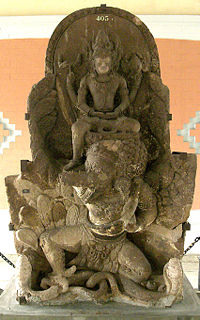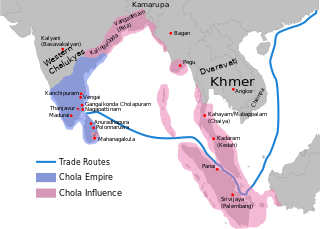Related Research Articles

The Mataram Kingdom was a Javanese Hindu–Buddhist kingdom that flourished between the 8th and 11th centuries. It was based in Central Java, and later in East Java. Established by King Sanjaya, the kingdom was ruled by the Shailendra dynasty and Ishana dynasty.
Po Binasuor, Ngo-ta Ngo-che, Cei Bunga, Chế Bồng Nga ruled Champa from 1360–1390 CE. He was also known as The Red King in Vietnamese stories. He is differed from Po Binnasuar, the king of Panduranga from 1306 - 1328.

Paṭṭiṉappālai is a Tamil poem in the ancient Sangam literature. It contains 301 lines, of which 296 lines are about the port city of Kaveripattinam, the early Chola kingdom and the Chola king Karikalan. The remaining 5 lines are on the proposed separation by a man who wants to move there and the separation pain of his wife who would miss her husband's love. Of the 301 lines, 153 are in the vanci meter and the rest are in akaval. It is sometimes referred to as Vancinetumpattu, or the "long song in the vanci meter". The poem was composed by Katiyalur Uruttirankannanar, sometime around 1st century and 2nd century CE, states Kamil Zvelebil – a Tamil literature scholar.
Dharmawangsa, stylized regnal name Sri Maharaja Isyana Dharmawangsa Teguh Anantawikramottunggadewa of the Isyana dynasty, was the last raja of the Kingdom of Medang, who reigned from 990 to 1016 CE. He also known by his posthumous name Wijayamreta Wardhana, which means "powerful in glorious death", which refer to his fight to the death.

Airlangga, regnal name Rakai Halu Sri Lokeswara Dharmawangsa Airlangga Anantawikramottunggadewa, was the only raja of the Kingdom of Kahuripan. The Kingdom was built from the territory of the Kingdom of Medang after Medang was sacked by king Wurawari of Lwaram. He gradually gained support, won back the kingdom once ruled by his uncle, and went on to become one of Java's most notable kings. Airlangga literally means "jumping water", thus his name means "he who crossed the water", described his life story; born in the court of Bali and during his youth crossed the Bali Strait to stay in Java and later ruled the kingdom in East Java. He belongs to both Isyana and Warmadewa lineages.

At the Battle of Bạch Đằng River in 938 near Hạ Long Bay in northern Vietnam the military force of the Vietnamese Principality of Jinghai, led by Ngô Quyền, a Vietnamese lord, defeated the invading forces of the Chinese state of Southern Han and put an end to centuries of Chinese imperial domination in Vietnam during the Five Dynasties and Ten Kingdoms period. It was considered the turning point in Vietnamese history.
Đại La, means the Citadel of the Great Dike, or La Thành was an ancient fortified city in present-day Hanoi during the third Chinese domination of the 7th and 8th centuries, and again in the 11th-century under Lý dynasty.
Lu Bode was a Chinese military leader during the Western Han dynasty.

Inscriptions and historical sources assert that the Medieval Chola Emperor Rajendra Chola I sent a naval expedition to Indochina, the Malay Peninsula and Indonesia in 1025 in order to subdue Srivijaya. The Thiruvalangadu plates, the Leyden grant, and the Tamil stele of Rajendra Chola I are the principal sources of information about the campaign.

Southeast Asia was in the Indian sphere of cultural influence from 290 BCE to the 15th century CE, when Hindu-Buddhist influences were incorporated into local political systems. Kingdoms in the southeast coast of the Indian Subcontinent had established trade, cultural and political relations with Southeast Asian kingdoms in Burma, Thailand, Indonesia, Malay Peninsula, Philippines, Cambodia and Champa. This led to the Indianisation and Sanskritisation of Southeast Asia within the Indosphere, Southeast Asian polities were the Indianised Hindu-Buddhist Mandala.

Lâm Ấp was a kingdom located in central Vietnam that existed from around 192 AD to 629 AD in what is today central Vietnam, and was one of the earliest recorded Champa kingdoms. The ruins of its capital, the ancient city of Kandapurpura is now located in Long Tho Hill, 3 kilometers to the west of the city of Huế.

Barus is a town and kecamatan (district) in Central Tapanuli Regency, North Sumatra Province, Sumatra, Indonesia. Historically, Barus was well known as a port town or kingdom on the western coast of Sumatra where it was a regional trade center from around the 7th or earlier until the 17th century. It was also known by other names, namely Fansur and possibly Barusai. The name Fansur or Pansur means "spring of water" in the local Batak language. Barus was well known for its produce camphor. In the 16th century, Barus came under attack from the rising power of Aceh, and became absorbed into the Aceh Sultanate. The earliest known Malay poet Hamzah Fansuri may be from Barus as indicated by his name.

Lamuri or Lambri was a kingdom in northern Sumatra, Indonesia from the Srivijaya period until the early 16th century. The area was inhabited by Hindu population around the seventh century. There is also evidence of Buddhism. The region is also thought to be one of the earliest places of arrival of Islam in the Indonesian archipelago, and in its later period its rulers were Muslims.

Chola Emperor Rajendra I launched naval raids on Srivijaya in maritime Southeast Asia in 1025, Rajendra's overseas expedition against Srivijaya was a unique event in India's history and its otherwise peaceful relations with the states of Southeast Asia. Several places in present-day Indonesia and Malaysia were invaded by Rajendra I of the Chola dynasty. The Chola invasion furthered the expansion of Tamil merchant associations such as the Manigramam, Ayyavole and Ainnurruvar into Southeast Asia. The invasion led to the fall of the Sailendra Dynasty of Srivijaya and also coincides with the return voyage of the great Buddhist scholar Atiśa from Sumatra to India and Tibet in 1025. The expedition of Chola influence on Srivijaya would last until 1070.
Sri Cudamani Warmadewa or Sri Cudamani Varmadeva or written as Shi-li-zhu-luo-wu-ni-fo-ma-tiao-hua, was an emperor of Srivijaya which belongs to the Sailendra dynasty, who reigned in Palembang in the late 10th century CE. He was known as an able and astute ruler, a clever tactician with shrewd diplomatic skills. His reign was quite renowned since during his period, the kingdom faced a dire crisis; the naval invasion of Javanese Medang Kingdom. He was the nemesis of King Dharmawangsa of Java.

Panduranga was the rump state successor of the Champa kingdom, which was destroyed by Vietnamese emperor Le Thanh Tong in 1471. Established by Bố Trì Trì, a Cham general who fled to the south after northern Champa was annexed by Dai Viet. It stood until late 17th century as the Nguyen lords of Cochinchina, a powerful Vietnamese clan, vassalized it and put the Cham polity under the name Principality of Thuan Thanh.

Dvaravati art is a form of artistic work originating from Mon. Dvaravati flourished from the Dvaravati Mon ancient artifacts are in present-day Thailand and Burma, Mon states to the west in southern Myanmar (Burma) and with the Mon state in northern Thailand. Dvaravati experienced political domination by neighbouring peoples on three occasions: in the 10th century, when the Burmese conquered the Mon state of Thaton west of the Tenasserim Yoma; from the 11th to the 13th century, when the Khmer Empire (Cambodia) arose in the east; and finally, in the late 13th century, when Dvaravati was absorbed by the Thai empire.

The Võ Cạnh inscription is the oldest Sanskrit inscription ever found in Southeast Asia, discovered in 1885 in the village of Võ Cạnh, about 4 km from the city of Nha Trang, Vietnam. This inscription is in the form of a 2.5 m high stone stele, with three uneven sides.
This is a timeline of the history of the Kingdom of Champa and its people–the Chams–an Austronesian-speaking ethnic group in Central Vietnam.
John Norman Miksic is an American-born archaeologist and one of the fifty foreigners recognized in Epigram Books' Not Born in Singapore: Fifth Personalities who Shaped the Nation. Sometimes referred to as "the Indiana Jones of Singapore's history," he has been cited as being one of the key figures who has changed historians' impressions of Southeast Asian history. "Through fragments of earthenware, Chinese pottery, Indian beads, and Javanese jewelry, Miksic and others have pieced together a new story--one that push[ed] the city's origins back some 500 years before Raffles arrival." As C. M. Turnbull of the University of Hong Kong wrote, the work of Miksic and his colleagues "will challenge historians to look at Singapore afresh in an attempt to re-unite twenty-first century Singapore with its distant past." He is perhaps best known for being the archaeologist who discovered archaeological evidence for Singapore's importance as an early major regional port, for literally "identifying it as a centre of commerce and culture in the 14th century." The evidence lies in the "eight tons of artifacts--evidence of a precolonial history that was largely neglected [previously]." As a result of Miksic's years of research and work, Singapore rewrote "the history taught in [its] secondary schools to expand the story of the island state's birth." He was recognized for his work when he was named the winner of Singapore's first 'Best Book on Singapore History' award in 2017. Wang Gungwu "said Prof Miksic’s work earned the gong because it laid the foundations for a fundamental reinterpretation of Singapore’s history and its place in the larger Asian context." Furthermore, Miksic "is a widely respected expert in the archaeology of Southeast Asia. His research interests range from the archaeology of ancient ports on the shors of the Straits of Malacca and the early cities in Indonesia, Cambodia and Myanmar to a deep knowledge of ceramics traded across India and southwest Asia."
References
- ↑ Miksic, John Norman; Yian, Goh Geok (2016). Ancient Southeast Asia. Taylor & Francis. p. 397. ISBN 9781317279044.
- 1 2 3 Chattopadhyaya, Alaka (1996-09-30). Atisa and Tibet: Life and Works of Dipamkara Srijnana in Relation to the History and Religion of Tibet with Tibetan Sources. Motilal Banarsidass. p. 90. ISBN 9788120809284.
- 1 2 The Journal of the Siam Society. s.n. 1975. pp. 226–228.
- 1 2 Miksic, John Norman; Yian, Goh Geok (2016). Ancient Southeast Asia. Taylor & Francis. p. 417. ISBN 9781317279044.